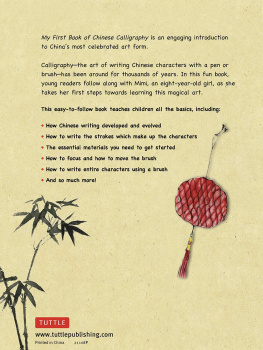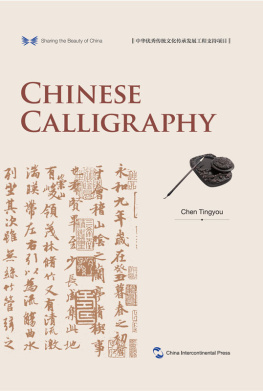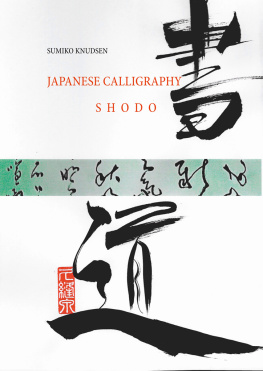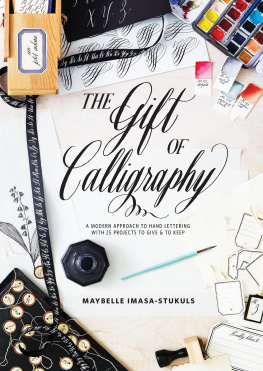Table of Contents
Guide
text by He Zhihong and Guillaume Olive
illustrations and calligraphy by He Zhihong
Books to Span the East and West
Tuttle Publishing was founded in 1832 in the small New England town of Rutland,
Vermont [USA]. Our core values remain as strong today as they were thento publish
best-in-class books which bring people together one page at a time. In 1948, we
established a publishing office in Japanand Tuttle is now a leader in publishing English
language books about the arts, languages and cultures of Asia. The world has become
a much smaller place today and Asias economic and cultural influence has grown. Yet
the need for meaningful dialogue and information about this diverse region has never
been greater. Over the past seven decades, Tuttle has published thousands of books on
subjects ranging from martial arts and paper crafts to language learning and literature
and our talented authors, illustrators, designers and photographers have won many
prestigious awards. We welcome you to explore the wealth of information available on
Asia at www.tuttlepublishing.com .
Published by Tuttle Publishing, an imprint of
Periplus Editions (HK) Ltd.
www.tuttlepublishing.com
English translation copyright 2022 Periplus
Editions (HK) Ltd.
Copyright 2006 Editions Philippe Picquier
All rights reserved. No part of this publication
may be reproduced or utilized in any form or by
any means, electronic or mechanical, including
photocopying, recording, or by any information
storage and retrieval system, without prior
written permission from the publisher.
Library of Congress Control Number: 2010928296
ISBN 978-0-8048-5516-7; ISBN 978-1-4629-0987-2 (Ebook)
Distributed by
North America, Latin America & Europe
Tuttle Publishing
364 Innovation Drive
North Clarendon, VT 05759-9436 U.S.A.
Tel: 1 (802) 773-8930;
Fax: 1 (802) 773-6993
www.tuttlepublishing.com
Asia Pacific
Berkeley Books Pte. Ltd.
3 Kallang Sector #04-01
Singapore 349278
Tel: (65) 6741 2178
Fax: (65) 6741 2179
www.tuttlepublishing.com
First edition
24 23 22 21 6 5 4 3 2 1
Printed in China 2110EP
TUTTLE PUBLISHING is a registered trademark of
Tuttle Publishing, a division of Periplus Editions
(HK) Ltd.
To Cathy
Contents
.....................
.....................
.....................
.....................
.....................
.....................
.....................
.....................
My name is Mimi, Im eight years old, and Im learning
Chinese calligraphy!
Chinese writing and calligraphy are two different things. People
often confuse the two. Kids in China learn to write with a pencil
or a pen, but they dont all practice calligraphyyou use a brush
for that. Calligraphy is the art of creating the characters
beautifully, not just writing them down. In China its been an
art for thousands of years, and its still very important today.
Just like famous paintings, wonderful Chinese calligraphy can be
displayed in museums and can be very valuable.
Together well start by discovering the rules of Chinese writing...
which are very different from our English writing rules. Then we'll
learn about the important ideas in calligraphy, and finally well
practice. As youll see, its not so hard. While you learn calligraphy,
you'll discover some other special talents too: how to master your
minds focus, your breathing, and even how you move!
But first, lets uncover the mysteries of Chinese writing, from
its beginnings
The Evolution
of Chinese Writing
A ccording to legend, there was once an extraordinary
being whose name was Cang Jie. He had two pairs of
eyes. One day, while observing animal tracks on the ground,
he copied them and got the idea of writing. Thats how he
invented Chinese characters.
Did you know the Chinese language has no alphabet? Chinese
characters are not letters, but drawings. Chinese writing is
one of the most ancient systems of writing in the world.
It appeared about six thousand years ago, on pottery,
when messages were painted and carved onto the clay.
Slowly, writing evolved. That means it developed and got more
complicated over time. At first writing was carved on turtle
shells and animal bones, then later it was carved on bronze
and stone. Characters were of different sizes and there
were many versions of the same word. But around the
year 200 B.C.E., the ruler nicknamed the first emperor,
Qin Shihuang, united the whole country and made rules to
follow about the way to write each character. Also, after
paper was invented, using a brush to write became common.
Century after century, Chinese characters have evolved
in different styles that youll learn about later in this
book. In 1956, China simplified many of the
characters by reducing the number
of strokes they had.
Chinese writing is made up of
around 10,000 characters.
In order to read the newspaper,
you have to know 3,000.
Look how the Chinese characters have evolved, from the way
they were written thousands of years ago to the way we
write them today:
Three peaks standing in the sky
represent the shape of a mountain
yes, youre right! This
character means mountain!
An outline that stretches its arm forward is
a person!
This one is easy, like a letter D, but
since you know that theres no alphabet
in Chinese: what looks like a D?
Its the moon!
A curving line that flows along,
with dots beside it like drops
or banks of a river is
water.
A person, with a stroke on top.
What do you think it is?
Its the sky!
Now its your turn! Guess which character goes with each drawing,
and write it in the correct box. (Answers start on .)
Sun
Earth
Grain
Net
Tree
The Order
of the Strokes
T he characters are made up of strokes. There can be just
one single stroke, or as many as thirty! But beware: you
have to write each one of them in a special order.
From top to bottom
Vertical (up and down) strokes are written from top to
bottom. When a character is made up of several parts, some
placed on top of others, you begin with the top ones, and
finish with the bottom ones.
Look at this character. It means two.
To write it, first write the top stroke,
then the bottom stroke.
From left to right
Horizontal (across) strokes are written from left to
right. When a character is made up of several parts,
some placed next to others, you begin on the left and
finish on the right.
To write person,
first write the left stroke, then the right stroke.
First middle, then left, then right
When a character is made up of a vertical center part with










